In this post, you’ll learn what is fluid flow in fluid mechanics and types of fluid flow with examples.
What is Fluid Flow?
When a fluid passes through a point or path the various parameters associated with the flow of fluid change in different patterns.
In this article, we will study, the classification of different types of fluid flow according to the conditional variance of flow parameters over space and time.
The two common parameters of any fluid flow are the velocity of the fluid particle and the pressure of the fluid under consideration. The flow of liquids can be divided into different patterns based on the variation of flow parameters with time and distance.
The advantage of characterizing the flow of fluids as some pattern helps to analyze it under the appropriate solution paradigm.
Read also: Fluid: Properties of Fluids [Briefly Explained]
Types of Fluid Flow
Following are the 6 different types of fluid flow:
#1 Steady Flow
A steady flow is one in which conditions (velocity, pressure, and cross-section) can vary from point to point, but do not change over time.
In real conditions, it is very rare to have such flows with parameters that are constant over time. The parameters usually change over time but the variance is within a small range such that the average of a particular parameter remains constant for a fixed time.
#2 Unsteady Flow
If at any point in the fluid, the conditions change over time, the flow is said to be unstable. (In practice there is always a slight difference in velocity and pressure, but if the average values are constant, the flow is assumed to be constant.
A constant flow can be uniform or non-uniform and thus, an unstable flow can also be uniform or non-uniform. For a steady flow, the discharge is constant over time, and for uniform flow, the area of the cross-section of the fluid flow through the flow stream is constant.
Read also: What is Pascal’s Law? Derivation and Applications
#3 Uniform Flow
If the flow parameter remains constant with distance along the flow path, then the fluid flow is known as uniform flow.
For a uniform flow, the area of the cross-section of the flow must remain constant. So a suitable example of uniform flow is the flow of a fluid through a pipeline of constant diameter. Conversely, the flow through a pipeline of variable diameter will be essentially non-uniform.
#4 Non-uniform Flow
The fluid flow is non-uniform if the flow parameters change and are varied at different points on the flow path.
If at a given moment, the velocity is not uniform at every point then the flow is non-uniform. (In practice, by this definition, each fluid that flows near a solid boundary will be non-uniform because the fluid at the boundary must have a boundary speed, usually zero. However, the flow is assumed to be uniform if the shape and size of the cross-section of the fluid stream are constant).
Read also: Difference Between Hydraulic and Pneumatic
By combining the above we can classify any flow into one of four types:
1. Steady Uniform Flow
Conditions do not change with position in the stream on with time. An example is the flow of water in a pipe of constant diameter at a constant velocity.
2. Steady Non-uniform Flow
The conditions vary from point to point in the stream but do not change over time. For example, the fluid flows in a taping pipe with a constant velocity in the inlet – the velocity will change as you move along the length of the pipe toward the exit.
3. Unsteady Uniform Flow
At a given moment, the conditions are the same at every point in a given time but will change with time. For example, a pipe of constant diameter connected to the pump pumping at a constant rate is then closed.
4. Unsteady Non-uniform Flow
Every state of the flow may change from point to point and over time at every point. For example waves in a channel.
3. One, two and Three-dimensional Fluid Flow
Although in general, all fluids flow in three-dimensional form, varying in all directions with pressure and velocity and other flow properties, in many cases, the largest change occurs in only two directions or even only in one.
In these cases, changes in the other direction can be effectively ignored so as to make the analysis more straightforward.
1. One-dimensional Flow
The flow is one-dimensional if the flow parameters like velocity, pressure, depth, etc. change only in the direction of flow at a given moment and not across the cross-section.
The flow may be unstable, in this case, the parameter alters in time but is still not across the cross-section. For an example of a one-dimensional flow is the flow in a pipe.
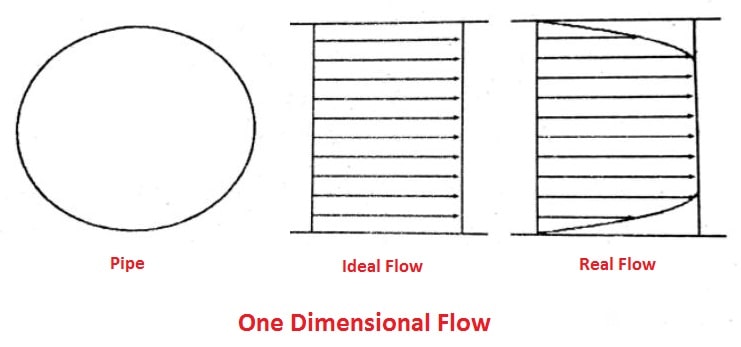
- All flow parameters can be expressed as functions of time and space coordinates only.
- Single space coordination is normally distance measured along the centre-line (not significantly straight) in which the fluid is flowing.
- In fact, the flow is never one dimensional because the viscosity reduces the velocity to zero at the solid boundaries.
- However, valuable results can often be obtained from “one-dimensional analysis” if the non-uniformity of the actual flow is not very great.
- The average values of the flow parameters on any section (perpendicular to the flow) are supposed to be used to the whole flow in that section.
2. Two-dimensional Flow
The flow is two-dimensional if it can be assumed that the flow parameters differ in this direction in the direction of flow and in one direction in the right angles.
In this type of flow, the streamlines are curved lines on one plane and are same on every parallel plane. An example is flowing over a weir for which typical streamlines can be seen in the figure below.
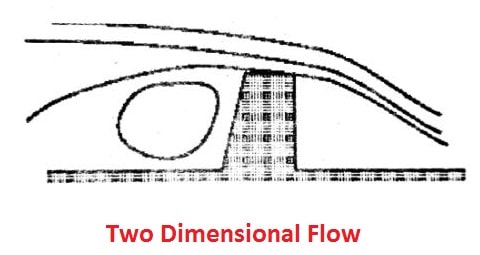
- All flow parameters are purposes of time and two space coordinates (say x and y).
- No variation in the z-direction.
- Similar streamline patterns are found in all planes for the z-direction in any instantaneous direction.
3. Three-dimensional Flow
In the three-dimensional fluid flow, the hydrodynamic parameters are functions of three space coordinates and time.
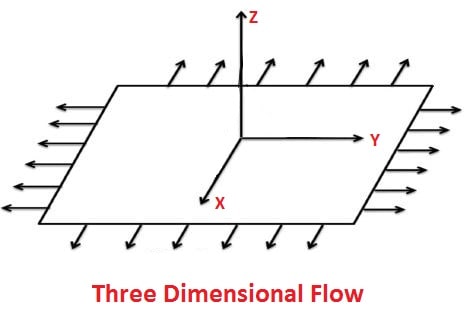
The motion of a fluid element in space simultaneously has three distinct characteristics.
- Translation
- Rate of deformation
- Rotation
4. Rotational or Irrotational Fluid Flow
1. Rotational Flow
It is the type of flow in which fluid particles also rotate on their own axis while flowing along the flow lines.
2. Irrotational Flow
It is a type of flow in which fluid particles do not rotate about their own axis when they flow along the flow lines.
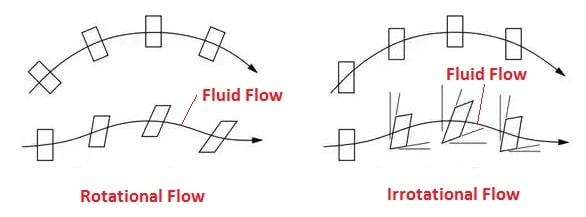
The angular momentum of the fluid elements is analyzed to classify any flow as rotational or Irrotational. If the angle within the two intersecting lines of the boundary of the fluid element turns while moving in the flow, then the flow is a Rotational Flow.
But if the fluid element rotates as a whole and there is no change in angles within the boundary lines, the flow cannot be rotational flow, so it is irrotational flow.
This means that in a rotational flow there must be some deformation in the fluid element. Such deformation of the fluid element or shear strain is certainly caused by tangential forces and shear stresses.
The shear stress is caused by viscosity, hence the flow of viscous fluid is rotational. Although this does not mean that the flow of non-viscous or ideal liquids is always Irrotational. The flow of typical fluids can be rotational by external work or heat interaction.
5. Laminar or Turbulent Flow
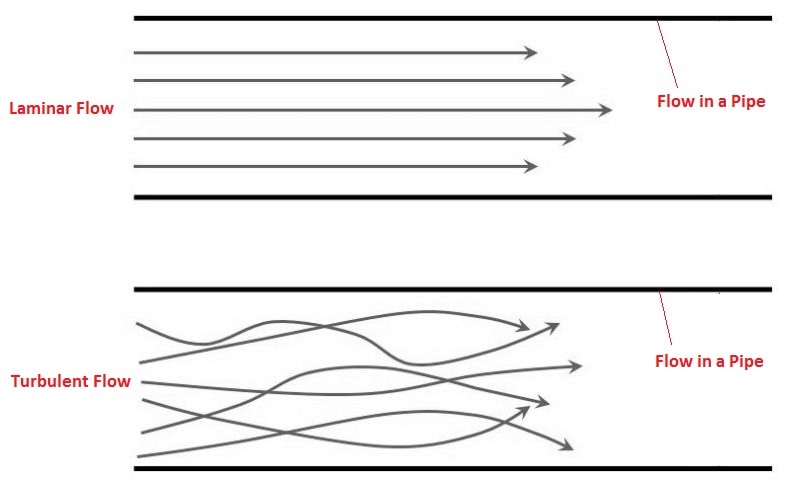
1. Laminar Flow
It is defined as a type of flow in which fluid particles move along a well-defined path or flow, and all streamlines are straight and parallel.
Thus the particles move in luminous or layers gliding smoothly over the adjacent layer. This type of flow is also known as viscous flow.
A moderately moving fluid flow consists of fluid layers moving past other layers such that some sheets are moving over other layers. Such flow of fluids is called Laminar Flow.
In Laminar flow, viscous shear stresses act among these layers of fluid which defines the velocity distribution within these layers of flow. The shear stress is defined by Newton’s equation for the shear stress in the laminar flow.
2. Turbulent Flow
The Turbulent flow is the type of flow in which fluid particles move in a zigzag manner. Due to the movement of fluid particles in a zigzag manner, eddies are formed which are responsible for the high energy loss.
As the flow speed of otherwise cool layers increases, these smoothly moving layers begin to increase randomly, and with further increase in flow velocity, the flow of fluid particles becomes totally random and no such laminar layer exists anymore. Shear stresses in turbulent flow are higher than those in laminar flow.
A dimensionless parameter, the Reynolds number, is described as the ratio of inertial and viscous forces to identify these two types of flow patterns. With an increase in flow velocity, the initial forces increase so the Reynolds Number.
For medium flow, the Reynolds number is below 2000 and for turbulent flow, it is above 2300. For the transition zone between the two types, the Reynolds number varies between 2000–4000.
6. Compressible or Incompressible Flow
1. Compressible Flow
Compressible flow is a type of fluid flow in which the density of the fluid varies from point to point or you can say, the density (ρ) is not constant for the fluid.
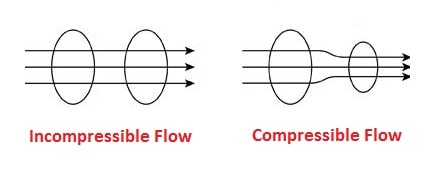
2. Incompressible Flow
It is the type of flow in which the density for fluid flow is constant. Liquids are generally incompressible while gases are compressible.
All fluids are compressible – even water – their density will change as pressure slightly changes. Under steady conditions, and provided that the change in pressure is small, it is possible to simplify the analysis of the flow and assume that it is incompressible and has a constant density.
As you will appreciate, compressing liquids is quite difficult so under most stable conditions they are considered ineligible. In some unstable conditions, there may be very high-pressure differences and these need to be taken into account for liquids as well.
Glasses, by contrast, are very easily compressed, in most cases requiring that they are treated as compressed, taking into account changes in pressure.
That’s it thanks for reading. If you like our article on “Types of Fluid Flow” please share with your friends. If you have any question about “Types of fluid flow” you can ask in the comments.
Read Next:
Hello! I really benefited a lot from this article , Why is there no article about Viscid and inviscid type of flow? I would really appreciate if you post about it. Thnx
Thanks for the suggestion! We’ll consider covering Viscid and inviscid flow in future articles. Stay tuned!
Man where were you when I was still schooling
Great reading material though!
Thanks for your feedback.
thank you so much
it is so much helpful though
You’re welcome. Keep visiting 😉